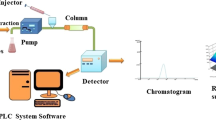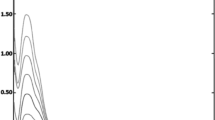Abstract
The equation that express the combined effect of the organic modifier content and mobile phase pH has been used to predict the chromatographic behavior of flurbiprofen, ibuprofen, diclofenic acid, ketoprofen, fenoprofen, naproxen, bezafibric acid and clofibric acid. Correlations between the retention factors of the solutes and pH of the mobile phase were determined from a set of 40 chromatograms for each compound at four different levels of acetonitrile composition (40, 45, 50 and 55 %, v/v), and at ten pH values in each acetonitrile–water mixtures. In this way, a complete description of the retention behavior of each solute in the space defined by the pH and organic modifier percentages variables was obtained. The optimized chromatographic condition was applied to quantitative determination of flurbiprofen, ibuprofen, and diclofenic acid in pharmaceutical dosage forms.





Similar content being viewed by others
References
Sweetman SC (ed) (2007) Martindale: the complete drug reference. 35th edn, Pharmaceutical Press, London
Sanborn KD (ed) (2007) Physicians desk reference (PDR), 61st edn. Medical Economics Company Inc., Montvale
Goodman and Gilman’s (1996) The pharmacological basis of therapeutics, Section V. 9th edn, CD ROM, McGraw-Hill Companies Inc
Demiralay EC, Alsancak G, Ozkan SA (2009) Determination of pKa values of nonsteroidal antiinflammatory drug-oxicams by RP–HPLC and their analysis in pharmaceutical dosage forms. J Sep Sci 32(17):2928–2936
Demiralay EC, Cubuk B, Alsancak G, Ozkan SA (2010) Combined effect of polarity and pH on the chromatographic behaviour of some angiotensin II receptor antagonists and optimization of their determination in pharmaceutical dosage forms. J Pharm Biomed Anal 53:475–482
Canbay HS, Demiralay EC, Alsancak G, Ozkan SA (2011) Chromatographic determination of pKa values of some water-insoluble arylpropionic acids and arylacetic acids in acetonitrile–water media. J Chem Eng Data 56:2071–2076
Sanli N, Fonrodona G, Barbosa J, Ozkan GA, Beltran JL (2005) Modelling retention in liquid chromatography of polyphenolic acids prediction of solvent composition and pH of the mobile phase. Anal Chim Acta 537:53–61
Barbosa J, Bergés R, Sanz-Nebot V (1998) Retention behaviour of quinolone derivatives in high-performance liquid chromatography; Effects of pH and evaluation of ionization constants. J Chromatogr A 823:411–422
García-Álvarez-Coque MC, Torres-Lapasió JR, Baeza–Baeza JJ (2006) Models and objective functions for the optimisation of selectivity in reversed-phase liquid chromatography. Anal Chim Acta 579:125–145
Bergés R, Sanz-Nebot V, Barbosa J (2000) Modelling retention in liquid chromatography as a function of solvent composition and pH of the mobile phase. J Chromatogr A 869:27–39
Pous-Torres S, Torres-Lapasió JR, Baeza–Baeza JJ, García-Álvarez-Coque MC (2007) Combined effect of solvent content, temperature and pH on the chromatographic behaviour of ionisable compounds. J Chromatogr A 1163(1–2):49–62
Pous-Torres S, Torres-Lapasió JR, Baeza–Baeza JJ, García-Álvarez-Coque MC (2008) Combined effect of solvent content, temperature and pH on the chromatographic behaviour of ionisable compounds. II. Benefits of the simultaneous optimization. J Chromatogr A 1193(1–2):117–128
Rosés M, Subirats X, Bosch E (2009) Retention Models for ionizable compounds in reversed phase liquid chromatography. Effect of variation of mobile phase composition and temperature. J Chromatogr A 1216:1756–1775
Nikitas P, Pappa-Louisi A (2002) New equations describing the combined effect of pH and organic modifier concentration on the retention in reversed- phase liquid chromatography. J Chromatogr A 971(1–2):47–60
Horváth C, Melander W, Molnár I (1977) Liquid chromatography of ionogenic substances with nonpolar stationary phases. Anal Chem 49:142–154
Espinosa S, Bosch E, Rosés M (2000) Retention of ionizable compounds on HPLC. 5. pH scales and the retention of acids and bases with acetonitrile–water mobile phases. Anal Chem 72(21):5193–5200
Subirats X, Bosch E, Rosés M (2006) Retention of ionisable compounds on high-performance liquid chromatography XV. Estimation of the pH variation of aqueous buffers with the change of the acetonitrile fraction of the mobile phase. J Chromatogr A 1121:170–177
Barbosa J, Bergés R, Sanz-Nebot V, Toro I (1999) Chromatographic behaviour of ionizable compounds in liquid chromatography. Part 2. Standardization of potentiometric sensors and effect of pH and ionic strength on the retention of analytes using acetonitrile-water mobile phases. Anal Chim Acta 389:43–52
Sun Y, Takaba K, Kido H, Nakashima MN, Nakashima K (2003) Simultaneous determination of arylpropionic acidic non-steroidal anti-inflammatory drugs in pharmaceutical formulations and human plasma by HPLC with UV detection. J Pharm Biomed Anal 30(5):1611–1619
Sajeev C, Jadhav PR, RaviShankar D, Saha RN (2002) Determination of flurbiprofen in pharmaceutical formulations by UV spectrophotometry and liquid chromatography. Anal Chim Acta 463(2):207–217
Sultan M, Stecher G, Stöggl WM, Bakry R, Zaborski P, Huck CW, El Kousy NM, Bonn GK (2005) Sample pretreatment and determination of non steroidal anti-inflammatory drugs (NSAIDs) in pharmaceutical formulations and biological samples (blood, plasma, erythrocytes) by HPLC-UV-MS and micro-HPLC. Curr Med Chem 12(5):573–588
Bhushan R, Joshi S, Arora M, Gupta M (2005) Study of the liquid chromatographic separation and determination of NSAID. J Planar Chromatogr 18(102):164–166
Iuliani P, Carlucci G, Marrone (2010) A investigation of the HPLC response of NSAIDs by fractional experimental design and multivariate regression analysis. Response optimization and new retention parameters. J Pharm Biomed Anal 51(1): 46–55
Mussini PR, Mussini T, Rondinini S (1997) Reference value standards and primary standards for pH measurements in D2O and aqueous-organic solvent mixtures: new accessions and assessments. Pure Appl Chem 69:1007–1014
Rondinini S, Mussini PR, Mussini T (1987) Reference value standard and primary standard for pH measurements in organic solvents and water–organic solvent mixtures of moderate to high permittivities. Pure Appl Chem 59:1549–1560
Barbosa J, Sanz-Nebot V (1991) Autoprotolysis constants and standardization of the glass electrode in acetonitrile-water mixtures. Effect of solvent composition. Anal Chim Acta 244:183–190
McNally R (2000) The United States Pharmacopoeia. 24th rev, Taunton, MA
Riley CM, Rosanske TW (1996) Development and validation of analytical methods. Elsevier, New York
Author information
Authors and Affiliations
Corresponding author
Rights and permissions
About this article
Cite this article
Secilmis-Canbay, H., Cubuk-Demiralay, E., Alsancak, G. et al. The Combined Effect of the Organic Modifier Content and pH of the Mobile Phase on the Chromatographic Behavior of Some Arylpropionic and Arylacetic Acids to Optimize Their Liquid Chromatographic Determinations. Chromatographia 75, 711–720 (2012). https://doi.org/10.1007/s10337-012-2255-z
Received:
Revised:
Accepted:
Published:
Issue Date:
DOI: https://doi.org/10.1007/s10337-012-2255-z




